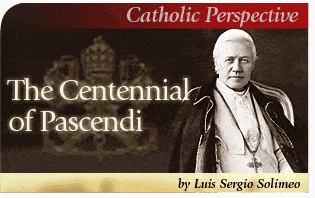 A hundred years ago, on September 8, 1907, Pope Saint Pius X (1903–1914) published the Encyclical Pascendi Dominici Gregis (Feeding the Lord’s Flock) against the devastating doctrines of Modernism.
A hundred years ago, on September 8, 1907, Pope Saint Pius X (1903–1914) published the Encyclical Pascendi Dominici Gregis (Feeding the Lord’s Flock) against the devastating doctrines of Modernism.
It was the culmination of an offensive that caused irreparable damage to Modernism. A month earlier, the Congregation of the Holy Office had published the Lamentabili Sane Decree condemning 65 distinct modernist propositions. Thus, it is fitting to celebrate the centennial of this great document that changed the Church’s history.
Historic Revisionism and Political Correctness
In these times of historic revisionism and political correctness, it becomes all the more necessary to celebrate the centennial of this great document since there are those who downplay the importance of Pascendi by denying the very existence of a Modernist conspiracy or even the errors Saint Pius X condemned. They claim the whole controversy was a misunderstanding caused by the pope’s excessive zeal. To their view, the saintly Pontiff simply did not understand the “genial” ideas of the new Church reformers who proved true precursors of the new times.
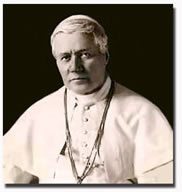
For example, one Catholic Web site notes:
[T]oday it is possible for us to have quite a different view [from Pascendi’s] about the Modernist crisis as a whole . . . it becomes ever clearer that the “conspiracy” evoked by that encyclical never existed. The times of the Modernist crisis were times of mutual incomprehension between those who proposed to renew Catholic thinking in its different aspects, exegesis, philosophy, dogmatics and spirituality, [and the Pope]. It also becomes ever clearer that the modernist system, as a system, was nothing but a construct of Pascendi.1
Saint Pius X, a Sentinel on the Lord’s Tower
However, truth is not found in politically correct historic revisionism. Rather, it is found in a serious study of the documents of the time about the Holy Pontiff and the modernists.2
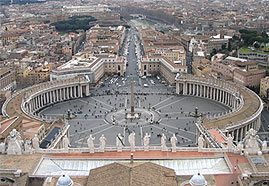
Saint Pius X’s unparalleled grandeur stands out by doing such an analysis. One can apply to him the words of Scripture, “I am upon the watchtower of the Lord, standing continually by day: and I am upon my ward, standing whole nights;”3 “The zeal of thy house hath eaten me up.”4
Modernism and Catholic Liberalism
Modernism did not appear suddenly, nor was it an isolated episode in the Church’s history. It was an integral part of the Church’s great struggle against those who sought to adapt the Church’s teachings and ways of being to the ideas and political regimes stemming from the Enlightenment and the French Revolution.
Pascendi builds upon the themes of its immediate predecessors, Mirari vos and Singularis nos, written by Pope Gregory XVI in 1832 and 1834, respectively, against the errors of religious indifference; Quanta Cura and the Syllabus, written by Pope Pius IX in 1864, condemning modern naturalism and rationalism; Imortale Dei, Libertas Praestantissima and Satis Cognitum, written by Pope Leo XIII in 1885, 1888 and 1896, respectively, against the philosophical, political and theological foundations of liberalism.
Thus, Saint Pius X affirms that the “Modernists offer nothing new—we find it condemned in the Syllabus of Pius IX, where it is enunciated in these terms: ‘Divine revelation is imperfect, and therefore subject to continuous and indefinite progress, which corresponds to the progress of human reason.’”5
The Conspiracy Is Published as a Novel
The plan to reform the Church was not a construct of Pascendi. It could be found in the works of the modernist movement and even in its literature.
In 1905, Antonio Fogazzaro, an Italian writer endowed with great literary talent, published the novel Il Santo (The Saint). It was placed on the Vatican’s Index of Forbidden Books the following year. Notwithstanding the prohibition, an English translation was published in the United States the following year. 6
In his novel, the author gradually expounds the principal ideas and goals of the modernist conspiracy. For example, a character participating in a meeting of reformist priests and laity from several countries explains:
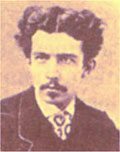
“Well … there are many Catholics in Italy and outside of Italy who, with us, desire certain reforms in the Church. We wish them to be brought about without rebellion, and be the work of the legitimate authorities. We desire reforms in religious instruction, ceremonies, clerical discipline, and reforms even in the highest sphere of ecclesiastical government. To obtain these ends, we need to create a current of opinion strong enough to induce the legitimate authorities to act in conformity with our views, be it twenty, thirty, or even fifty years hence.”7
Later on, another conspirator speaks about the work they are carrying out, “Catholic freemasonry? Yes, the freemasonry of the catacombs.”8 Further ahead in the plot, two priests walk down a dark street looking for a house where the conspirators are gathering. As one of them hesitates, doubting whether they find themselves before the right house, the other exclaims, laughing, “Go in, go in! There is an odor of Luther in the air; it must be here.”9
“A Silent and Secret Work”
In a letter of August 24, 1908, Father George Tyrrell, S.J., explained, “We must wait for the day when, thanks to a silent and secret work, we will have gained a larger following in the Church for the cause of liberty.”10
Father Alfred Loisy (1857–1949), excommunicated by Saint Pius X, stated, “The avowed modernists form a fairly definite group of thinking men united in the common desire to adapt Catholicism to the intellectual, moral and social needs of today.”11 And elsewhere, “The fundamental principle of modernism is, ‘the possibility, the necessity and the legitimacy of evolution in understanding the dogmas of the Church, including that of papal infallibility and authority, as well as in the manner of exercising this authority.’”12
Hence there cannot be any doubt about the modernist conspiracy’s existence and its ultimate nefarious goal.
Saint Pius X Unveils the Modernist Conspirators’ Tactics
Having looked at the conspiracy as described by the modernists themselves, let us now see how Saint Pius X described it: “Modernists . . . recruit followers to the extent of forming a secret society (clandestinum foedus) . . . are injecting the virus of their doctrine into the veins of Christian society.”13 The modernist tactic, the pope said, was to unleash “bitterness and hatred [up]on Catholics who zealously fight the battles of the Church” by accusing them of “ignorance or obstinacy.” At the same time, “they seek to make a conspiracy of silence around them to nullify the effects of their attack” and turn into a martyr any of their friends who is punished by legitimate authority. For this reason, the pope emphasizes, “[t]he young, excited and confused by all this clamor of praise and abuse, some of them afraid of being branded as ignorant, others ambitious to rank among the learned, and both classes goaded internally by curiosity and pride, not infrequently surrender and give themselves up to Modernism.”14 And, the saintly pope continues, “What efforts do they not make to win new recruits! They seize upon professorships in the seminaries and universities, and gradually make of them chairs of pestilence.”15
Conspiracy Theory?
In dealing with historical conspiracies, there are two errors. One is the simplistic error of reducing everything to mere conspiracies. The second is to also deny, a priori, the possibility of any conspiracies. By his very nature, man tends to associate with those who think like him or share the same interests or goals, as the old Latin adage says, similis simili gaudet (like rejoices in like). This natural tendency often gives rise to groups, organizations or movements of people who gather not only to discuss their interests but to coordinate their efforts for victory. History has seen all kinds of conspiracies, cabals, political machinations, military plots, theologians’ factions, and so forth. Thus, speaking of a modernist conspiracy whose goal is to change the Church is hardly absurd. Saint Pius X himself speaks of a “secret society.”
Modernist Doctrines
Below are quotes that summarize the doctrine denounced in the Encyclical with subtitles to facilitate understanding.
The fundamental error: An alliance of false philosophy with theology
“41. Their whole system, containing as it does errors so many and so great, has been born of the union between faith and false philosophy.”
It is an evolutionist, agnostic philosophy that denies the value of human reason and the supernatural; and destroys the basis of theology that are the motives of credibility
“35. Thus do they argue, not perceiving that their determination of the primitive germ is only an a priori assumption of agnostic and evolutionist philosophy, and that the germ itself has been gratuitously defined so that it may fit in with their contention.”
“6. Modernists place the foundation of religious philosophy in that doctrine which is usually called Agnosticism. According to this teaching human reason is confined entirely within the field of phenomena, that is to say, to things that are perceptible to the senses, and in the manner in which they are perceptible; it has no right and no power to transgress these limits. Hence it is incapable of lifting itself up to God, and of recognizing His existence, even by means of visible things. From this it is inferred that God can never be the direct object of science, and that, as regards history, He must not be considered as an historical subject. Given these premises, all will readily perceive what becomes of Natural Theology, of the motives of credibility, of external revelation.”
Religion is reduced to an irrational sentiment, the supernatural to a “religious experience” and the divinity of Christ to a psychological phenomenon
“7. However, this Agnosticism is only the negative part of the system of the Modernist: the positive side of it consists in what they call vital immanence . . . . [R]eligion . . . is due to a certain necessity or impulsion; but it has its origin, speaking more particularly of life, in a movement of the heart, which movement is called a sentiment.”
“10. Therefore the religious sentiment, which through the agency of vital immanence emerges from the lurking places of the subconsciousness, is the germ of all religion, and the explanation of everything that has been or ever will be in any religion. . . . even supernatural religion; it is only a development of this religious sentiment. Nor is the Catholic religion an exception; it is quite on a level with the rest; for it was engendered, by the process of vital immanence, in the consciousness of Christ, who was a man of the choicest nature, whose like has never been, nor will be.”
“30. [T]hey proclaim that Christ, according to what they call His real history, was not God and never did anything divine, and that as man He did and said only what they, judging from the time in which he lived, can admit Him to have said or done.”
“31. [T]hey oppose the history of the faith to real history precisely as real. Thus we have a double Christ: a real Christ, and a Christ, the one of faith, who never really existed[.]
Dogmas are fruits of sentiments and evolve
“12. Thus, We have reached one of the principal points in the Modernists’ system, namely the origin and the nature of dogma. . . .
“To ascertain the nature of dogma, we must first find the relation which exists between the religious formulas and the religious sentiment. This will be readily perceived by him who realizes that these formulas have no other purpose than to furnish the believer with a means of giving an account of his faith to himself.”
“13. Hence it is quite impossible to maintain that they express absolute truth: for, in so far as they are symbols, they are the images of truth, and so must be adapted to the religious sentiment in its relation to man …. Consequently, the formulae too, which we call dogmas, must be subject to these vicissitudes, and are, therefore, liable to change. Thus the way is open to the intrinsic evolution of dogma.”
Not only dogmas must evolve, but also Church structures and the liturgy
“38. From all that has preceded, some idea may be gained of the reforming mania which possesses them: in all Catholicism there is absolutely nothing on which it does not fasten…. Regarding worship, the number of external devotions is to be reduced, or at least steps must be taken to prevent their further increase, though, indeed, some of the admirers of symbolism are disposed to be more indulgent on this head. Ecclesiastical government . . . [has to be in] spirit with the public conscience, which is not wholly for democracy; a share in ecclesiastical government should therefore be given to the lower ranks of the clergy, and even to the laity, and authority should be decentralized.”
In moral matters, Modernists follow Americanism
“38. With regard to morals, they adopt the principle of the Americanists, that the active virtues are more important than the passive, both in the estimation in which they must be held and in the exercise of them.”
Destroying priestly celibacy
“38. The clergy are asked to return to their ancient lowliness and poverty, and in their ideas and action to be guided by the principles of Modernism; and there are some who, echoing the teaching of their Protestant masters, would like the suppression of ecclesiastical celibacy.”
Faith must be subject to science
“17. On the side of science the independence is indeed complete, but it is quite different with regard to faith, which is subject to science . . . .”
Likewise, the Church must be subject to the State
“24. In the same way . . . as faith and science are strangers to each other by reason of the diversity of their objects, Church and State are strangers by reason of the diversity of their ends, that of the Church being spiritual while that of the State is temporal. Formerly it was possible to subordinate the temporal to the spiritual and to speak of some questions as mixed, allowing to the Church the position of queen and mistress in the same, because the Church was then regarded as having been instituted immediately by God as the author of the supernatural order. But his doctrine is today repudiated alike by philosophy and history. The State must, therefore, be separated from the Church, and the Catholic from the citizen. Every Catholic, from the fact that he is also a citizen, has the right and the duty to work for the common good in the way he thinks best, without troubling himself about the authority of the Church, without paying any heed to its wishes, its counsels, its orders—nay, even in spite of its reprimands. To trace out and prescribe for the citizen any line of conduct, on any pretext whatsoever, is to be guilty of an abuse of ecclesiastical authority, against which one is bound to act with all one’s might. The principles from which these doctrines spring have been solemnly condemned by our predecessor Pius VI in his Constitution Auctorem fidei [against Jansenists].”
All religions are good because they express religious sentiment; the Catholic religion may be more perfect, but not the only true religion
“14. [W]ith such theories, . . . the way is opened wide for atheism. [O]nce . . . given this doctrine of experience united with the other doctrine of symbolism, every religion, even that of paganism, must be held to be true. What is to prevent such experiences from being met within every religion? In fact that they are to be found is asserted by not a few. And with what right will Modernists deny the truth of an experience affirmed by a follower of Islam? With what right can they claim true experiences for Catholics alone? . . . In the conflict between different religions, the most that Modernists can maintain is that the Catholic has more truth because it is more living and that it deserves with more reason the name of Christian because it corresponds more fully with the origins of Christianity. That these consequences flow from the premises will not seem unnatural to anybody.”
Modernism is the synthesis of all heresies, destroys the notion of religion and already contains atheism, to which it leads
“39. And now, can anybody who takes a survey of the whole system be surprised that We should define it as the synthesis of all heresies? What remains, then, but the annihilation of all religion—atheism?”
“6. But how the Modernists make the transition from Agnosticism, which is a state of pure nescience, to scientific and historic Atheism, which is a doctrine of positive denial[?] . . . Yet it is a fixed and established principle among them that both science and history must be atheistic: and within their boundaries there is room for nothing but phenomena; God and all that is divine are utterly excluded.”
“39. The first step in this direction was taken by Protestantism; the second is made by Modernism; the next will plunge headlong into atheism.”
Modernism is nothing but a form of pantheism
“39. For if all the intellectual elements, as they call them, of religion are pure symbols, will not the very name of God or of divine personality be also a symbol, and if this be admitted will not the personality of God become a matter of doubt and the way opened to Pantheism? And to Pantheism that other doctrine of the divine immanence leads directly. For does it, We ask, leave God distinct from man or not? If yes, in what does it differ from Catholic doctrine, and why reject external revelation? If no, we are at once in Pantheism.”
Moral causes of Modernism: Curiosity and pride
“40. That the proximate and immediate cause consists in a perversion of the mind cannot be open to doubt. The remote causes seem to us to be reduced to two: curiosity and pride. . . .
“[I]t is pride which exercises an incomparably greater sway over the soul to blind it and plunge it into error, and pride sits in Modernism as in its own house, finding sustenance everywhere in its doctrines and an occasion to flaunt itself in all its aspects. It is pride which fills Modernists with that confidence in themselves and leads them to hold themselves up as the rule for all, pride which puffs them up with that vainglory which allows them to regard themselves as the sole possessors of knowledge, and makes them say, inflated with presumption, We are not as the rest of men, and which, to make them really not as other men, leads them to embrace all kinds of the most absurd novelties; it is pride which rouses in them the spirit of disobedience and causes them to demand a compromise between authority and liberty; it is pride that makes of them the reformers of others, while they forget to reform themselves . . . .”
Intellectual causes: Abandonment of Scholastic philosophy
“41. If we pass from the moral to the intellectual causes of Modernism, the first which presents itself, and the chief one, is ignorance. Yes, these very Modernists who pose as Doctors of the Church, who puff out their cheeks when they speak of modern philosophy, and show such contempt for scholasticism, have embraced the one with all its false glamour because their ignorance of the other has left them without the means of being able to recognize confusion of thought, and to refute sophistry. Their whole system, with all its errors, has been born of the alliance between faith and false philosophy.”
“42. They recognize that the three chief difficulties for them are scholastic philosophy, the authority of the fathers and tradition, and the magisterium of the Church, and on these they wage unrelenting war. For scholastic philosophy and theology they have only ridicule and contempt.”
Remedies:
Study of Scholastic philosophy
“45. In the first place, with regard to studies, We will and ordain that scholastic philosophy be made the basis of the sacred sciences. . . . And let it be clearly understood above all things that the scholastic philosophy We prescribe is that which the Angelic Doctor has bequeathed to us . . . . [L]et Professors remember that they cannot set St. Thomas aside, especially in metaphysical questions, without grave detriment.”
Rigorous selection of candidates to the priesthood
“49. [D]iligence and severity are to be used in examining and selecting candidates for Holy Orders. Far, far from the clergy be the love of novelty! God hates the proud and the obstinate.”
Bishops’ vigilance over new writings
“50. It is also the duty of the bishops to prevent writings infected with Modernism or favorable to it from being read when they have been published, and to hinder their publication when they have not. No book or paper or periodical of this kind must ever be permitted to seminarian or university students. The injury to them would be equal to that caused by immoral reading—nay, it would be greater for such writings poison Christian life at its very source.”
Bishops must forsake prudence of the flesh and act fearlessly
“51. [T]he Bishops, putting aside all fear and the prudence of the flesh, despising the outcries of the wicked, gently by all means but constantly, do each his own share of this work.”
“55. Let [the Bishops] combat novelties of words remembering the admonitions of Leo XIII. (Instruct. S.C. NN. EE. EE., 27 Jan., 1902): It is impossible to approve in Catholic publications of a style inspired by unsound novelty which seems to deride the piety of the faithful and dwells on the introduction of a new order of Christian life, on new directions of the Church, on new aspirations of the modern soul, on a new vocation of the clergy, on a new Christian civilization.”
Protection from Our Lord Jesus Christ and Our Lady, who alone crushed all heresies
“58. May Jesus Christ, the author and finisher of our Faith, be with you by His power; and may the Immaculate Virgin, the destroyer of all heresies, be with you by her prayers. And We, as a pledge of Our affection and of divine assistance in adversity, grant most affectionately and with all Our heart to you, your clergy and people the Apostolic Benediction.”
A Move as Important as the Victory in Lepanto
It is fitting to close this article with the following commentary, written by Professor Plinio Corrêa de Oliveira, to commemorate the fiftieth anniversary of the Encyclical:
“If Saint Pius X had not fulminated the Modernist heresy, the world would have quickly marched toward pantheism and atheism. As a result, the whole action of communism all over the earth would not have met the enormous obstacles it did.
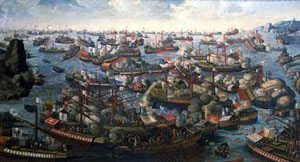
“The condemnation of Modernism was, therefore, an historical event as important as the victory in Lepanto. Thus, [by canonizing Saint Pius X] Pius XII must be eternally remembered by mankind since he has given us such a great saint as model and protector.”16
Footnotes
- Pierre Colin, Modernisme et crise moderniste, http://www.esprit-et-vie.com/breve.php3?id_breve=63 (emphasis added) (author’s translation).
- Cf. Émile Poulat, Histoire, dogme et critique dans La Crise Moderniste, (Paris: Casterman, 1962); Father Arthur Veermerch, “Modernism,” at http://www.newadvent.org/cathen/10415a.htm; James M. Egan, O.P., S.T.D., Pius X and the Integrity of Doctrine, in Episcopal Committee of The Confraternity of Christian Doctrine, A Symposium on the Life and Work of Pope Pius X, (Washington, DC: Confraternity of Christian Doctrine,
1946), 56; James J. Kelly, ed., The Letters of Baron Friedrich Von Hugel and Maude D. Petre: The Modernist Movement in England, http://books.google.com/books?id=7osQKEmnxLEC&pg=PR19&lpg=PR19
&dq=petre+ms+maud+d&source=web&ots=t2AReKA87D&sig=SbcoMGjgqxrRT36I_bBrsT-mF0#PPP1,M1; Thomas T. McAvoy, C.S.C., The Great Crisis in American Catholic History—1895-1900 (Chicago: Henry Regnery Company, 1957); Francis Beauchesne Thornton, The Burning Flame—The Life of Pope Pius X,
(New York: Benzinger Brothers, 1952); Father Hieronymo Dal-Gal, Saint Pius X (Dublin: M.H. Gill and Son, 1954); Igino Giordani, Pius X (Milwaukee, WI: The Bruce Publishing Co., 1954); José-Maria Javierre,
Pío X, (Barcelona: J. Flors, 1951); José-Maria Javierre, Merry del Val (Barcelona: J. Flors, 1961); Alberto Caturelli, “La Pascendi Dominici Gregis, una encíclica profética,” e-aquinas (April 2007), http://www.e-aquinas.net/file.php?url=1176067246.pdf&doc=589. - Isaias 21:8.
- John 2:17.
- Pope Pius IX, Syllabus, section I, “Pantheism, Naturalism, and Absolute Rationalism,” note 5, Welcome to the Catholic Church on CD-ROM, CD-ROM, version 2.00, Harmony Media Inc., 2001.
- Antonio Fogazzaro, The Saint (New York: G.P. Putnam’s Sons, 1906).
- Ibid. 52 (emphasis added).
- Ibid. 68 (emphasis added).
- Ibid. 285 (emphasis added).
- Quoted by J. Rivière, Modernisme, in Vacant-Mangenot-Aman, Dictionnaire de Théologie Catholique, t. X, deuxieme partie, col. 2042 (Paris: Letouzey et Ané, 1929) (author’s translation).
- Cited by Father Arthur Veermerch, “Modernism,” http://www.newadvent.org/cathen/10415a.htm.
- Ibid.
- Saint Pius X, Motu proprio, Sacrorum Antistitum, Introduction (September 1, 1910) (emphasis added).
- Pope Pius X, Pascendi Dominici Gregis, “On the Doctrines of the Modernists,” 42, http://www.vatican.va/holy_father/pius_x/encyclicals/documents/hf_p-x_enc_19070908_pascendi-domini ci-gregis_en.html.
- Ibid. 43. All subsequent paragraphs numbers are indicated at the start of each quotation.
- Plinio Corrêa de Oliveira, “O cinqüentenário da Pascendi,” Catolicismo (São Paulo, Brazil, September 1957).

